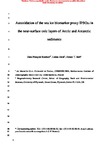Autoxidation of the sea ice biomarker proxy IPSO <inf>25</inf> in the near-surface oxic layers of Arctic and Antarctic sediments
| dc.contributor.author | Rontani, JF | |
| dc.contributor.author | Smik, L | |
| dc.contributor.author | Belt, Simon | |
| dc.date.accessioned | 2019-03-24T17:55:24Z | |
| dc.date.issued | 2019-02-08 | |
| dc.identifier.issn | 0146-6380 | |
| dc.identifier.uri | http://hdl.handle.net/10026.1/13527 | |
| dc.description.abstract |
© 2019 Over the last decade or so, the mono- and di-unsaturated highly branched isoprenoid (HBI) lipids IP 25 (Ice Proxy with 25 carbon atoms) and IPSO 25 (Ice Proxy for the Southern Ocean with 25 carbon atoms) have emerged as useful proxies for sea ice in the Arctic and Antarctic, respectively. A more complete understanding of their respective proxy signatures, however, requires more detailed knowledge of their stability in the water column and in sediments. In the current study, we focused on the autoxidation of IPSO 25 , first by performing laboratory-based oxidation reactions on a purified sample and characterizing products based on detailed mass spectral analysis. We then analysed for the same oxidation products in near-surface sediments retrieved from the Arctic and the Antarctic, and some suspended organic matter from the Antarctic. Our data show that IPSO 25 is susceptible to partial autoxidation within the oxic layers of Arctic and Antarctic sediments, while the same processes appear not to be so important in the water column. Although the number of primary autoxidation reactions identified in sediments was not as large as in laboratory experiments, there was evidence for their subsequent modification by biotic degradation. Quantifying the extent of degradation of IPSO 25 and IP 25 in sediments, and thus the impact of such process on the use of these biomarkers as paleo sea ice proxies, remains challenging at this stage, since most of the primary oxidation products do not accumulate, likely due to secondary biodegradation reactions. Some interesting differences in reactivity were also observed between IPSO 25 and IP 25 present in the same Arctic sediments. This suggests that factors other than environmental control may influence the IPSO 25 /IP 25 ratio (i.e. DIP 25 ) in Arctic sediments. | |
| dc.format.extent | 63-76 | |
| dc.language | en | |
| dc.language.iso | en | |
| dc.publisher | Elsevier BV | |
| dc.subject | IPSO25 | |
| dc.subject | Degradation | |
| dc.subject | Autoxidation | |
| dc.subject | Arctic and Antarctic sediments | |
| dc.subject | Biotic and abiotic interactions | |
| dc.subject | IP25 | |
| dc.subject | DIP25 | |
| dc.title | Autoxidation of the sea ice biomarker proxy IPSO <inf>25</inf> in the near-surface oxic layers of Arctic and Antarctic sediments | |
| dc.type | journal-article | |
| dc.type | Journal Article | |
| plymouth.author-url | https://www.webofscience.com/api/gateway?GWVersion=2&SrcApp=PARTNER_APP&SrcAuth=LinksAMR&KeyUT=WOS:000460896700006&DestLinkType=FullRecord&DestApp=ALL_WOS&UsrCustomerID=11bb513d99f797142bcfeffcc58ea008 | |
| plymouth.volume | 129 | |
| plymouth.publication-status | Published | |
| plymouth.journal | Organic Geochemistry | |
| dc.identifier.doi | 10.1016/j.orggeochem.2019.02.002 | |
| plymouth.organisational-group | /Plymouth | |
| plymouth.organisational-group | /Plymouth/Faculty of Science and Engineering | |
| plymouth.organisational-group | /Plymouth/Faculty of Science and Engineering/School of Geography, Earth and Environmental Sciences | |
| plymouth.organisational-group | /Plymouth/REF 2021 Researchers by UoA | |
| plymouth.organisational-group | /Plymouth/REF 2021 Researchers by UoA/UoA07 Earth Systems and Environmental Sciences | |
| plymouth.organisational-group | /Plymouth/Research Groups | |
| plymouth.organisational-group | /Plymouth/Research Groups/Marine Institute | |
| plymouth.organisational-group | /Plymouth/Users by role | |
| plymouth.organisational-group | /Plymouth/Users by role/Academics | |
| plymouth.organisational-group | /Plymouth/Users by role/Researchers in ResearchFish submission | |
| dcterms.dateAccepted | 2019-02-07 | |
| dc.rights.embargodate | 2020-2-8 | |
| dc.rights.embargoperiod | Not known | |
| rioxxterms.versionofrecord | 10.1016/j.orggeochem.2019.02.002 | |
| rioxxterms.licenseref.uri | http://www.rioxx.net/licenses/all-rights-reserved | |
| rioxxterms.licenseref.startdate | 2019-02-08 | |
| rioxxterms.type | Journal Article/Review |


